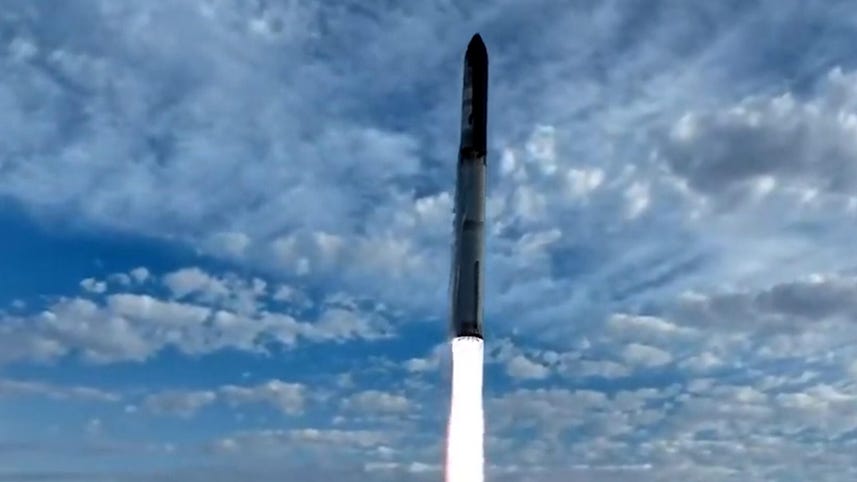
Speaker 1: Two minus
Speaker 2: 10, 9, 8, 7, 6, 5, 4, 3, 2, 1 30
Speaker 3: [00:00:30] Seconds into flight. We are feeling the rumble. We are seeing 33 out of 33 Raptor engines ignited on the super heavy booster
Speaker 1: Booster and ship avionics [00:01:00] power and telemetry. Nominal
Speaker 3: This point, we’ve already passed through max, that maximum dynamic pressure and passing Supersonics. So we’re now moving faster than the speed of sound, getting those onboard views from the ship cameras. Alright, counting down now we’re going to be coming up right at around the three minute mark on that hot staging maneuver. Again, we’ll see the booster engines [00:01:30] start to shut down. You’ll see all but three lights go out in the middle and then we’ll see the engines ignite on ship pushing it away and that will start carrying the ship into space. Booster will start to do its flip and then move into the boost back burn, setting it up before eventually splash down in the Gulf of Mexico
Speaker 1: State.
Speaker 3: [00:02:00] Hot staging confirmed booster’s now making its way back. Scene six engines ignited on ship. Kate, we got a Starship on its way to space and a booster on the way back to the Gulf.
Speaker 4: Everything is looking good for both the first stage on the left hand side of your screen or the super heavy booster as well as on the right hand side of your screen. That is Starship. Or we also [00:02:30] refer to that as the ship.
Speaker 5: So for landing burn, we’re going to expect to see the 13 center engines light rapidly, bring down the booster’s velocity and then just the three in the center for splash down. Let’s see if that’ll work. We’re getting a engines [00:03:00] add acquisition of signal. Let’s see if we can get some other video of that. Now this is a test objective today. It is still something that we’re attempting to learn and to make it that far to demonstrate the controlled reentry up to that point is pretty darn good ship. Continuing to look nominal with its ascent burn
Speaker 6: Ship engine cutoff.
Speaker 4: There we go. [00:03:30] As you heard there by the out and from the crowd behind us, starships six Raptor engines have successfully shut down. We heard a call out for nominal orbital insertion, which is incredible. Look at these views, dad.
Speaker 5: I can’t believe we’re [00:04:00] seeing it in space. This is awesome. Wonderful. Now we are going to be coasting for the next about 30 minutes or so. We’ll be back around the T plus 40 minute mark and that’ll be Starship continuing to coast hit those ambitious test objectives and then continue on to reentry. Oh man, we can see the heating on those flaps as we’re starting to reenter the ER’s atmosphere. This is where the ER’s atmosphere is doing the work to slow us down.
Speaker 4: Now, like we said, this plasma [00:04:30] field wow is, wow, what a view we hope to maintain these views throughout. Starship is so big that we’re hoping that the plasma field doesn’t entirely blanket the entire vehicle right now. It is not. The star links are still
Speaker 5: Views brought to you by starlink. Yeah, the star links
Speaker 4: Are still communicating and still capturing the data and the video that we see here. I mean, Shiva, this is just absolutely incredible views. We’ve never seen anything like this before. This is the biggest flying object [00:05:00] ever in space.
Speaker 5: Absolutely Kay. And it’s important to note the ascent burn that we did was to get us two orbital velocities, even though we were on a nearly orbital trajectory. So the heating and the loads that Starship is going through right now are what it would be getting if it were recovering from an orbital mission and just the fact that we have used through entry. This is incredible. Yeah.
Speaker 4: Again, this is the furthest and fastest that Starship has ever flowed [00:05:30] and you could definitely tell by the crowd here in Hawthorne,
Speaker 5: The heat chill tiles doing their work. We talked about it earlier, up to 2,600 degrees Fahrenheit, that those heat chill tiles are dissipating as we are reentering.
Speaker 4: The atmosphere is actually doing us a huge favor here by acting as a braking system for Starship as it reenters the
Speaker 5: Atmosphere. And that’s part of the reason why the flaps are so important. [00:06:00] We’re using the body of Starship and the drag from the atmosphere to slow us down from orbital speed. But you want the vehicle to remain stable. You want those heat shield tiles pointed down so they can absorb the heat of the Earth’s atmosphere.
Speaker 3: For now though, we are just still waiting to see if we’re going to get some signal back. We’re currently at a loss of signal with Starship. Don’t know for sure what its status is and so we’re just continuing to listen in. But it was pretty incredible seeing the flaps [00:06:30] really do their thing to maneuver the vehicle as it’s moving through hypersonic. We are making the call now that we have lost ship 28. So as we were possibly expecting, we lost the data a couple of minutes ago. We haven’t heard from the ship up until this point and until the team has made the call, that ship has been lost. So no splash down today, but again, just it’s incredible to see how much further we got this time around.




















+ There are no comments
Add yours